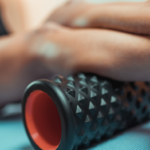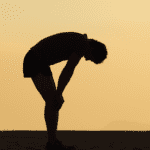You woke up feeling energetic, grabbed your running shoes, embraced your feeling of motivation, decided to hit your favorite 10km route, and finished an incredible run. Expecting to feel fantastic, as you do after all your runs… all of a sudden you feel completely exhausted…
Running fatigue is a physical state of exhaustion that occurs when one runs too hard or runs long distances regularly. Without the body recovering fully, causing fatigue that is carried over to the next training session. It takes time for the body to repair the muscle fibers and make improvements after sessions.
Every time you go for a run, your body has to adapt to get stronger…
When you run, you aren’t just building your stamina and strength; you’re also breaking your body down, causing a tiny amount of tissue damage with every step.
So, allowing yourself time to recover after your runs is what makes it possible for you to come back better adapted for your next run.

Why Is Rest As Important As Running?
As runners, we all love running, but we neglect one BIG part of our training… RECOVERY.
We can’t stress the importance of recovery enough. It is as important as your training.
Without recovery, you won’t reach your full running potential. On top of that, by not recovering you increase your chances of getting sick and injured.
What happens when we exercise and push ourselves is that we do damage to our system. (We hurt ourselves on a very, very low – healthy & stimulating level.)
When we recover the body repairs the damage that was made and makes improvements.
In other words, it improves the system, so that the system can withstand more next time you exercise.
These small improvements are why we get fitter, faster and stronger.
When we train too hard and do not include enough recovery, we are not allowing the full repair and compensational reaction to that damage.
Let’s dive into how to tell if you have given your body enough time to repair the damage.

How Do You Know If You Are Not Recovering Properly?
Fatigue
Fatigue is the first and most obvious sign. SOME fatigue is normal, if we are training hard, we can’t expect to never be tired and to feel a bit flat on some runs.
You shouldn’t feel tired and exhausted all the time.
When you are tired, your alarm bells should ring, but you may not necessarily need to act just yet.
If you’ve got normal recovery cycles built into each week, or if you know that you’ve got an easy run ahead of you then you can recover before you run again.
Inability To Fall Asleep
Inability to fall asleep (when you don’t usually have sleep issues) is a second sign that you aren’t recovering properly.
If you find that you are struggling to fall asleep and are feeling fatigued then you need to add more time to your recovery sessions.
If fatigue, inability to fall asleep and low appetite are what you are feeling then this is a DEFINITE sign that you need to make a change to your training program and include a lot more recovery time.
The combination of fatigue, loss of appetite, and inability to fall asleep tells us that your body is releasing high levels of cortisol to help you cope.

Should You Be Taking An Entire Day Off For Recovery?
At Coach Parry we advocate taking one full day off a week to recover, this is because it has less to do with physical recovery and a lot more to do with mental recovery.
For example: If you put a swim on your rest day, it’s probably going to be helpful to recovery.
But…
What we have found over the years is that, if you can have one day where you don’t have to think about training and you don’t have to plan your life around training, then you will recover mentally and physically.
Check out this video where Brad and Lindsey talk about the importance of both physical and mental recovery as a runner.
The 2 Big Recovery Run Mistakes You’re Making
Recovery runs versus easy runs… do you know the difference between the two?
Recovery run: This is a run that means you are still doing some exercise but are doing it at a low enough intensity so that you are still allowing yourself some time for recovery.
In a recovery run, you are supposed to be doing just enough to get the heart rate up and effectively circulate the blood through those working muscles. If there is pain and stiffness in your muscles then we recommend not doing a recovery run and rather doing a recovery spin on a bicycle or swimming with extremely low resistance.

Biggest Mistakes Made When Doing a Recovery Run
Running too hard and too long. It’s very easy to run too hard on a recovery run because you can still run a long, easy run.
A recovery run should never be longer than 45 minutes and should be a super easy, super slow, little shuffle.
If you would like to know more about your recovery runs, then this video is for you.
Did you know that there are 3 simple things you can do after every run to make sure you lower your risk of getting injured, recover quickly and make sure you’re feeling your best by the time your next run comes around?
What You Should Be Doing After Every Run
- Cool Down
- Muscle Recovery
- Correct Nutritional Intake
Cool Down
By ‘cool down’, we mean slowing down, dropping your heart rate, and flushing the body.
You can do this by walking to lower the heart rate slowly right after your run. Bringing your Heart Rate down slowly, allows your blood vessels to also contract so that you do have a sudden drop in blood pressure, feel dizzy and risk falling post-exercise.
If you skip your cool-down sessions, on your next run you will take longer to warm up and longer to get into your running rhythm. You will also start to feel that stiffness in your muscles.
Muscle Recovery
Muscle recovery can be done with some static stretching or even some foam rolling.
Foam rolling is effective because it helps create more blood flow to your muscles, which will aid your recovery a lot quicker and may get you ready for your run a lot faster. (Just remember to be gentle with the foam rolling as you don’t want to bruise any of your muscles)
For foam rolling to be effective, you need to make sure you are rolling all the prime movers from running: glutes, hamstrings, and quads (your lower limbs especially.)
Static stretching is very much a subjective kind of feeling. If you enjoy it, then go ahead.
If you prefer static stretching, we recommend doing them post and not pre-workout (See why Here) & holding those stretches for up to 30 seconds, anything less is not worth your time. Aim to stretch all the muscle groups that were involved in your run, in particular the glutes and hip flexors.
Nutrition Intake
This varies depending on the type of run you’re doing, whether it’s a long run, a high-intensity run, or an easy run.
Let’s have a look at a high-intensity session and a long run.
After both of these run’s, you should try to intake 1 gram of carbs per kg of body mass per hour that you have exercised and if you can put some protein in with the carbs, then you’ll be kickstarting the process of rebuilding the muscle that was broken down during exercise.

So, you know why you need to recover, you know how to recover… Let’s have a look at ways to speed up your recovery time.
How To Speed Up Recovery
The harder you train, the more important your cool down becomes.
When you do high-intensity runs, then your cool down should be some very light jogging/walking. If you have done a longer run, then your cool down should be a walk to slow down your heart rate.
Consume good quality recovery products.
Within 30 minutes after your training, you should consume the correct sugars and protein. As we get older this becomes even more important. You should also drink enough as keeping hydrated will also contribute to speeding up your recovery time.
Why should it be within 30 minutes?
During exercise, we have what are called gated channels. These are channels through which the body takes sugar out of the blood, through the membranes, and then pushes them into the muscles where they are needed most.
The gated channels are very sensitive during exercise, but they close down and draw that sugar into the muscles much slower once you get out of the 30-minute window.
So, essentially, every 15 minutes, our body’s ability to replace the muscle glycogen, in particular, decreases by roughly a multiplier of 50. (50% less efficient as we go). Therefore 45 to 60 minutes after our exercise it becomes difficult for our bodies to reload that muscle glycogen.

Coach Parry’s Best Kept Recovery Drink Secret: Chocolate Milk.
Chocolate milk contains milk, which has a particular amino acid (Leucine), which is important in aiding recovery – especially in older athletes and the chocolate has plenty of sugar.

Stretch or foam roll.
As we discussed above, static stretching or foam rolling will increase the blood flow to those muscles which will aid in speeding up your recovery time.
Recovery is all-important, especially after an intensive training session. The quicker you recover, the sooner you see the benefits and the sooner you can take on your next intense training session.
If you would like to discover more about the 3 methods of speeding up your recovery after a run as we touched on above, then watch this short YouTube Video that we published recently that will go into a lot more detail.
The fact is, not running is just as important as fitting in a run. Rest days provide all the benefits you need to reinvigorate your athletic spirit so that you will want to continue training.




Comments are closed.